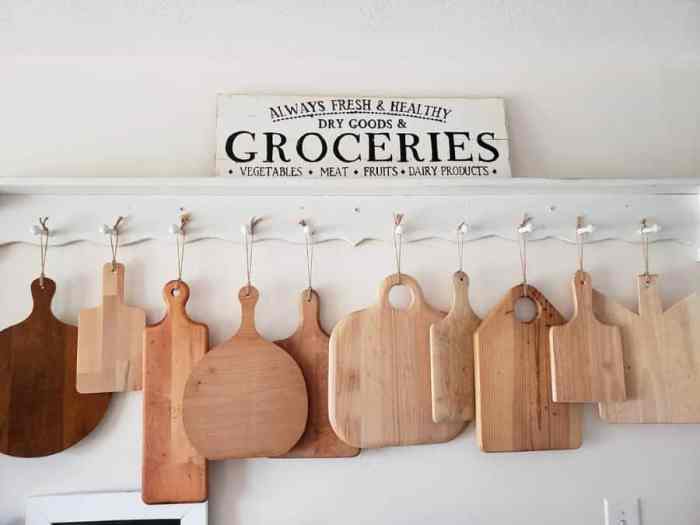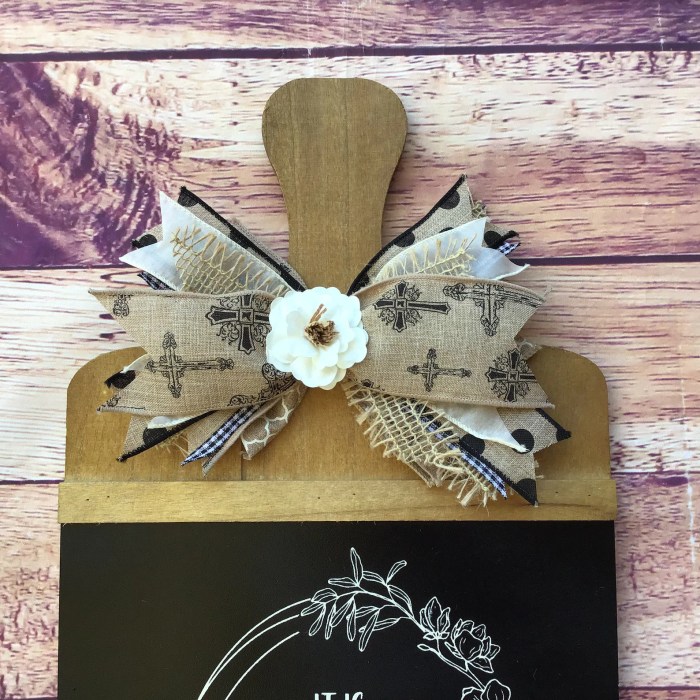Kitchen Cutting Board Decor For Walls: Transform your kitchen from ordinary to extraordinary with this unique and stylish decorating trend. This guide explores the diverse world of using cutting boards as wall art, showcasing various materials, design styles, and mounting techniques. Discover how to seamlessly integrate this unexpected décor element into your kitchen’s overall aesthetic, creating a space that’s both functional and visually stunning.
From rustic charm to modern minimalism, the versatility of cutting boards allows for endless creative possibilities. We’ll delve into the specifics of choosing the right materials—wood, bamboo, plastic—and finishes, considering their aesthetic qualities and suitability for wall display. Learn how to arrange multiple boards to create eye-catching patterns or use a single statement piece as a focal point. We’ll also cover practical aspects like secure mounting methods and decorative techniques to personalize your wall art.
Design Ideas and Styles for Cutting Board Wall Decor

Transforming humble kitchen tools into striking wall art is a surprisingly versatile design choice. Cutting boards, with their inherent rustic charm and varied materials, offer a unique opportunity to enhance any kitchen’s aesthetic, from cozy farmhouse to sleek modern. Their natural variations in wood grain and color add texture and warmth, creating a focal point that’s both functional and visually appealing.
Cutting Board Styles and Their Integration into Kitchen Design Schemes
The adaptability of cutting boards allows seamless integration into diverse kitchen styles. Rustic kitchens, characterized by warm wood tones and vintage accents, pair beautifully with distressed or naturally aged cutting boards. These boards, perhaps showing signs of use, contribute to the overall sense of lived-in comfort. In contrast, modern kitchens, emphasizing clean lines and minimalist aesthetics, benefit from sleek, polished cutting boards in neutral colors like white or light gray.
These boards, possibly made from materials like marble or sleek wood, create a sense of understated elegance. Farmhouse kitchens, with their blend of rustic and contemporary elements, can accommodate a wider range of styles, from intricately carved wooden boards to simpler, painted options. Minimalist kitchens benefit from a single, large, unadorned cutting board, acting as a subtle yet impactful design element.
Creative Cutting Board Wall Arrangements, Kitchen Cutting Board Decor For Walls
Arranging multiple cutting boards on a wall offers endless possibilities for creative expression. Consider the size, shape, and color variations of your boards when planning your arrangement. Careful consideration of these factors allows for the creation of visually appealing patterns and groupings that enhance the overall aesthetic of the space. A carefully planned arrangement can transform a simple collection of functional items into a statement piece of wall art.
- Patterns: Arrange boards in repeating patterns, such as a grid, herringbone, or even a more abstract design. The visual impact is heightened by using boards with similar sizes and colors.
- Groupings: Cluster cutting boards of varying sizes and colors together to create a visually interesting focal point. This method works particularly well when incorporating boards with different textures and finishes.
- Symmetrical Arrangements: For a more formal look, arrange cutting boards symmetrically around a central point. This creates a sense of balance and order, lending sophistication to the space.
Examples of Cutting Board Wall Arrangements
Here are three distinct examples demonstrating how to create visually compelling arrangements using different numbers and sizes of cutting boards:
- Arrangement 1: Rustic Charm (5 Boards): This arrangement features five rectangular cutting boards of varying sizes and shades of wood. The largest board is positioned centrally, with two smaller boards flanking it on either side, and two even smaller boards placed above the larger board, creating a balanced, yet slightly asymmetrical, design. The overall aesthetic is warm and inviting, reflecting a classic rustic style.
The natural variations in the wood grain contribute to the overall rustic charm.
- Arrangement 2: Modern Minimalism (3 Boards): This arrangement showcases three large, square cutting boards of the same size and color (a pale, neutral gray). They are arranged in a simple horizontal row, creating a clean and minimalist look that complements a modern kitchen design. The uniformity of the boards creates a sense of calm and sophistication.
- Arrangement 3: Farmhouse Fusion (7 Boards): This arrangement combines seven cutting boards of varying sizes, shapes, and colors. It includes rectangular and round boards, some painted white, others in natural wood tones, and a few with subtle decorative elements. They are arranged in a slightly haphazard yet visually pleasing cluster, creating a sense of relaxed farmhouse charm. The mix of textures and colors adds visual interest without overwhelming the space.
The arrangement reflects the eclectic nature of farmhouse style.
Adding Decorative Elements to Cutting Board Wall Art: Kitchen Cutting Board Decor For Walls

Transforming ordinary cutting boards into stunning wall art involves adding decorative elements that enhance their aesthetic appeal and reflect personal style. This process allows for the creation of unique pieces that add character and charm to any room. The choice of decorative technique depends on the desired outcome and the level of artistic skill.
Stenciling Techniques for Cutting Board Decoration
Stenciling offers a straightforward method for adding intricate designs to cutting boards. This technique involves applying paint through a stencil onto the board’s surface. Various stencil materials exist, including reusable plastic stencils, which are durable and easily cleaned, and temporary paper stencils, ideal for one-time use. Acrylic paints are a popular choice due to their vibrant colors and quick drying time.
To achieve a clean, professional look, use painter’s tape to secure the stencil firmly to the board, preventing paint bleed. Multiple layers of paint can be applied for a bolder effect. For example, a floral stencil can create a rustic, farmhouse-style design, while a geometric stencil can contribute to a modern, minimalist aesthetic.
Painting Techniques and Materials for Cutting Board Wall Art
Painting directly onto the cutting board allows for greater creative freedom. Acrylic paints are well-suited for this purpose, offering a wide range of colors and finishes. Before painting, the cutting board should be thoroughly cleaned and sanded smooth to ensure even paint application. For a distressed look, consider applying a base coat of a contrasting color before layering the main color.
This technique can create a vintage or antique feel. For instance, a base coat of white followed by a layer of distressed blue can evoke a shabby-chic style. Alternatively, freehand painting allows for the creation of personalized designs, such as landscapes, portraits, or abstract art.
Decoupage: Adding Images and Patterns to Cutting Boards
Decoupage is a technique that involves adhering decorative paper, fabric, or images to a surface, then sealing them with multiple layers of varnish or sealant. Mod Podge is a common decoupage medium, providing a strong adhesive and protective finish. The chosen images can be printed from a computer, cut from magazines or newspapers, or sourced from decorative paper.
For example, vintage maps, botanical illustrations, or family photos can be incorporated to create a personalized piece of wall art. Multiple layers of Mod Podge are essential to create a smooth, durable finish that protects the image from wear and tear.
Carving Designs into Cutting Boards for Wall Art
Carving designs directly into the wood of a cutting board creates a unique, three-dimensional effect. This requires specialized tools, such as wood carving chisels and gouges, and a steady hand. Simple designs are recommended for beginners, while more experienced carvers can tackle intricate patterns. Safety precautions are crucial, including wearing protective eyewear and gloves to prevent injuries.
For instance, carving a simple geometric pattern, such as a series of concentric circles, can add visual interest to the cutting board. More complex designs might involve floral motifs, animal shapes, or even personalized initials.
Incorporating Personalized Elements into Cutting Board Designs
Adding personalized elements, such as family initials, names, or meaningful quotes, elevates the cutting board from a decorative piece to a cherished keepsake. These elements can be incorporated using various techniques, including stenciling, painting, or carving. For example, family initials can be stenciled in a contrasting color, creating a subtle yet personalized touch. A meaningful quote can be carefully hand-painted, or deeply carved into the wood.
These personal touches add sentimental value and make the artwork truly unique.
Safety Precautions When Decorating Cutting Boards
When using paints, sealants, or other materials on cutting boards intended for wall display, it’s essential to prioritize safety. Always work in a well-ventilated area to minimize exposure to fumes. Wear appropriate protective gear, such as gloves and eye protection, to prevent skin irritation or eye damage. Ensure all materials are non-toxic and food-safe if the cutting board might be used for food preparation in the future (although this is less likely if it’s primarily intended for wall art).
Allow ample drying time before handling the decorated cutting board to prevent smudging or damage. For carving, always use sharp tools with caution and maintain a firm grip to prevent accidental slips.
Ultimately, decorating your kitchen walls with cutting boards offers a unique blend of practicality and artistic expression. By thoughtfully selecting materials, designs, and mounting methods, you can create a truly personalized and visually captivating space. Whether you opt for a rustic gallery wall or a single, modern statement piece, the possibilities are as diverse as your culinary creativity. So, unleash your inner designer and transform your kitchen into a reflection of your unique style.